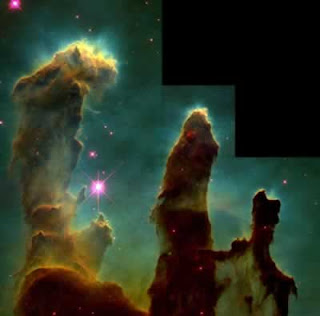Supernova 1987A
Since 51.4 kiloparsecs is approximately 168,000 light-years, the cosmic event itself happened approximately 168,000 years ago. To put this in perspective, Homo sapiens sapiens (modern humans) evolved about 200,000 years ago.
Crab Nebula
The nebula contains a pulsar in its centre which rotates thirty times per second, emitting pulses of radiation from gamma rays to radio waves. The nebula was the first astronomical object identified with a historical supernova explosion.
Protoplanetary Disks
According to NASA, nebulae, flattened disks of gas and dust, "are the likely birthplaces of new planetary systems. Hubble provided visual proof that pancake-shaped dust disks around young stars are common, suggesting that the building blocks for planet formation are in place."
Antennae Galaxies
The chaotic swirls of blues and oranges represent a firestorm of new star birth ignited by the head-on collision of interstellar hydrogen. The long arcing insect-like "antennae" represent matter flung from the scene of the accident.
Cat's Eye Nebula
Modern studies reveal several mysteries. The intricacy of the structure may be caused in part by material ejected from a binary central star, but as yet, there is no direct evidence that the central star has a companion. Also, measurements of chemical abundances reveal a large discrepancy between measurements done by two different methods, the cause of which is uncertain.
Eskimo Nebula
The Eskimo Nebula is clearly a planetary nebula. It is surrounded by gas that composed the outer layers of a Sun-like star only 10,000 years ago. The visible inner filaments are ejected by strong wind of particles from the central star. The outer disk contains unusual light-year long orange filaments. NGC 2392 lies about 5000 light-years away and is visible with a small telescope in the constellation of Gemini.
Gamma Ray Explosion
According to NASA, gammaray bursts "may represent the most powerful explosions in the universe since the Big Bang, the explosive birth of our universe. Hubble images showed that these brief flashes of radiation come from far-flung galaxies that are forming stars at enormously high rates. By pinpointing the host galaxies, Hubble also identified the sources of the 'bursts': the collapse of massive stars."
Hubble Deep Field
The field is so small that only a few foreground stars in the Milky Way lie within it; thus, almost all of the 3,000 objects in the image are galaxies, some of which are among the youngest and most distant known. By revealing such large numbers of very young galaxies, the HDF has become a landmark image in the study of the early universe, and it has been the source of almost 400 scientific papers since it was created.
Pale Blue Dot
Sagan said the famous Earthrise picture taking during the Apollo 8 mission,showing the entire Earth above the moon, forced humans to step back and see the Earth as just a part of the universe. In the spirit of that realization, Sagan said he pushed for Voyager to take a photo of the Earth from itsvantage point on the edge of the solar system.
There was danger to the spacecraft's optics from the nearby Sun. Voyager took similar pictures of Venus, Jupiter, Saturn, Uranus and Neptune. Thus the Pale Blue Dot photo was part of a "portait" of the Solar System that was created by Voyager 1.
Pillars of Creation
This Hubble image, showing star forming pillars in the Eagle Nebula, is one of the most popular poster images of outer space, and often appears in science-fiction movies. The Eagle Nebula was one of the space regions passed through during the opening "zoom out" shot of the movie Contact (1997), and appeared in the opening scene of the Babylon 5 episode Into The Fire. The Eagle Nebula, along with the Hourglass Nebula, was featured in the liner notes of Pearl Jam's 2000 album Binaural.
























